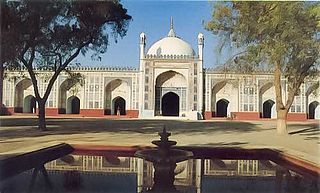Top Qs
Timeline
Chat
Perspective
Subah of Multan
Subdivision of the Mughal Empire between 1580–1752 From Wikipedia, the free encyclopedia
Remove ads
The Subah of Multan (Punjabi: ملتان دا صوبہ, romanized: Multān Dā Sūbāh; Persian: صوبه ملتان, romanized: Sūbāh-ey-Multān) was one of the three subahs (provinces) of the Mughal Empire in the Punjab region, alongside Lahore and Delhi subahs.[2] It was also amongst the original twelve Mughal provinces, encompassing southern parts of Punjab, stretching towards parts of the regions of Pashtunistan and Balochistan, bordering Kandahar Province and the Persian Safavid Empire. It was one of the largest and most important provinces of the Mughal Empire.[3] The province was annexed by Durrani Empire in 1752, with Ali Mohammad Khakwani as its first Durrani governor.
Remove ads
Geography
The subah of Multan was bordered to the north by the Lahore Subah and Kabul Subah, to the west by the Safavid Empire and for some time the Kandahar Subah, to the east by the Ajmer Subah and Delhi Subah, and to the south by the Thatta Subah.
History
The Subah of Multan was one of twelve administrative divisions created by the Mughal Emperor Akbar in 1580.[4] Multan city acted as the capital of the Multan Subah according to the Ain-i-Akbari.
Economy
Under Mughal rule, Multan enjoyed 200 years of peace in a time when the city became known as Dar al-Aman ("Abode of Peace"). During the Mughal era, Multan was an important centre of agricultural production and manufacturing of cotton textiles.[5] Multan was a centre for currency minting,[5] as well as tile-making during the Mughal era.[6]

Multan would remain an important trading centre until the city was ravaged by repeated invasions in the 18th and 19th centuries in the post-Mughal era.[7] Many of Multan's merchants then migrated to Shikarpur in Sindh,[7] and were found throughout Central Asia up until the 19th century.[7]
Multan was also host to the offices of many commercial enterprises during the Mughal era,[5] even in times when the Mughals were in control of the even more coveted city of Kandahar, given the unstable political situation resulting from frequent contestation of Kandadar with the Persian Safavid Empire.[5]
Administrative divisions
The Multan Subah was divided into sarkars (equivalent to districts), with them being as follows as per the Ain-i-Akbari:[8]
The sarkars were subdivided into pargannahs (equivalent to sub-districts or tehsils).
Remove ads
List of governors
The following is a list of notable governors of Multan subah appointed by the central Mughal government.[4][9][10]
16th century
- Syed Hamid Bukhari (c. 1580–1587)
- Sadiq Khan (c. 1587–1590)
- Muhib Ali Khan (c. 1590–1594)
- Rustam Mirza (c. 1594–1602)
- Said Khan (c. 1602–1605)
17th century
- Mirza Ghazi Beg (c. 1605–1606)
- Tashi Beg (c. 1606–1611)
- Abdul Nabi Uzbek (1611–1613)
- Baqir Khan Najam Sani (1613–1620)
- Khan Jahan Lodi (1620–1624)
- Asaf Khan (c. 1624–1631)
- Qulij Khan Turrani (1631–1638)
- Yusuf Khan (1638–1639)
- Najabat Khan (1639–1641)
- Qulij Khan Turrani (1641–1642)
- Said Khan Bahadur (1642–1643)
- Murad Baksh (1643–1646)
- Said Khan Bahadur (1646–1647)
- Bahadur Khan Rohela (1647–1649)
- Aurangzeb (1649–1653)
- Dara Shikoh (1653–1657)
- Lashkar Khan (1658)
- Tarbiat Khan (1658–1667)
- Saif Khan (1667–1668)
- Tahir Khan (1668–1669)
- Lashkar Khan (1669–1671)
- Mubariz Khan (1671–1672)
- Khwaja Abid Khan (1672–1674
- Diler Khan (1674–1676)
- Muhammad Azam Shah (1676–1678)
- Muhammad Akbar (1678–1687)
- Mir Ashiq (1687–1695)
- Allahyar Khan (1695–1696)
18th century
- Abdus Samad Khan (1726–1737)
- Zakariya Khan (1737–1745)
- Shah Nawaz Khan (1745–1747)
- Zahid Khan (1747–1748)
- Kaura Mal (1748–1751)
Remove ads
See also
Notes
- The area of the sarkars is based on the years 1595–6/1601. The revenue figures are the official estimates for jama or naqdī as per the Ain-i-Akbari. However, the revenue figures do not take into account the regional variations in price-levels. The jama' is stated in dams (a copper coin). At the time of the Ain-i-Akbari one rupee was worth 40 dams.
References
Wikiwand - on
Seamless Wikipedia browsing. On steroids.
Remove ads

